
|   |

|   |
 e-mail: sunilkothari1933@gmail.com Delectable Kathak recitals in Delhi February 6, 2018 Aditi Mangaldas's two choreographic works Celebrated Kathak exponent Aditi Mangaldas, disciple of Kumudini Lakhia and Pt Birju Maharaj, has charted her own path in Kathak dance. Trained in classical Kathak she has had distinct advantage of traditional Kathak under Birju Maharaj and looking at classical Kathak from contemporary angle under Kumudini Lakhia. Her work 'Within' presented at Delhi's Kamani Hall on Jan 18, 2018 by Natya Ballet Centre was divided into two parts: 'Knotted' which is choreographed as contemporary Kathak and 'Unwrapped' choreographed in classical Kathak. 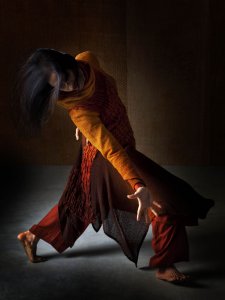 Photo: Dinesh Khanna 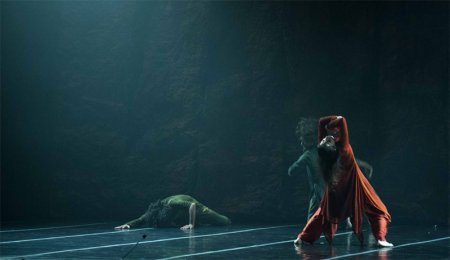 Photo: Noni Chawla In her choreographer's note, Aditi mentions: 'Choreographing 'Within' has been a very different experience from my last few works. It has been about delving deep into the self and exploring our deepest emotions, however disturbing they may be. Needless to say, the process of creating it has sometimes been almost too close for comfort.' Aditi further mentions that it is the journey she invites audiences to take with her. And it is a journey for 50 minutes that one watches in the beginning listening to the sounds of drums in various degrees, wondering why the dancers run from one wing to another and back, in darkness with little light that outlines their figures, clothes, hair. And the running seems endless. Then the dancers start taking typical Kathak chakkars, raise their arms, palms covering their faces suggesting agony, falling on floor, rising and running to the wings. Similar movements are performed by other group of three dancers. The intensity increases, a solo dancer performs the same movements. Bodies fall on the floor, roll, get up, again fall, with sheer helplessness, despair, raising arms, crying for help from powers above. The light plays an important role creating further mystery, adding to the feelings of ennui, moving without any direction, struggling to release themselves of these disturbing feelings. Music composition by Ish Shehrawat with diffused drum beats, tabla by Mohit Gangani, pakhavaj by Ashish Gangani, cello by Saskia Rao de Haas enhance the agonized feelings. Light design by Fabiana Piccioli and executed by Douglas Finley, stage designed by Manish Kansara, with rugged brown black wall, reflecting the mood of despair, sound executed by Yogesh Dhawan to compliment the mood, all speak of commendable teamwork. Credit for special mentoring and dramaturgy is given to Farooq Choudhry, whereas mentoring was done by Morag Deyes. Script and dramaturgy is by Vani Subramanian. Costumes are designed by Kimi Nakano and realized by Sandhya Raman. Credit for research is given to Ragini Pasricha and Aditi. The dancers were Aditi, Gauri Diwakar, Minaz, Sunny Shishodiya, Manoj Kumar, Aamrapali Bhandari and Anjana Kumari. This obviously gives one an idea of collaboration with so many creative people. All the components of light, sound, costumes, music, sound effects, backdrop, and over all mentoring and dramaturgy, research and script writing constitute major partners in Aditi's contemporary Kathak. Aditi's Drishtikon Foundation has now a sound base for these collaborative works. It has been a regular practice in contemporary dance to see the continuous repetition of movements to make a statement, to the point that the audiences not used to such nature of contemporary dance, start feeling uncomfortable. There seems no respite. And that is where Aditi as a choreographer achieves her aim. In classical dance terminology it is through 'angikabhinaya', where the entire body speaks that contemporary dance seems to have evolved its body movement language. Indian contemporary dance seems to follow international standards. Aditi has carved her own niche in the international contemporary dance scene. Hers is a long journey and it has been relentless. The dancers perform with high energy and one marvels at the technique evolved that astounds the audiences. 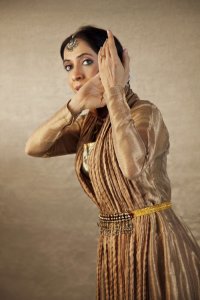 Photo: Dinesh Khanna 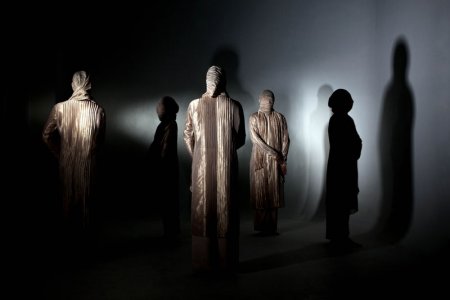 Photo: Dinesh Khanna The second part 'Unwrapped' based on classical Kathak warrants what Aditi has quoted from the writings of J.Krishnamurti. 'Do the times compel us to look 'within'? To recognize our deepest, most complex emotions? To explore our innermost spaces, where humanity and brutality, masculinity and femininity, good and bad seem to lie in half embrace? Waiting to be disentangled. Waiting to be recognized beyond the binaries. Waiting to find expression in ways that shape our lives, our actions, ourselves. To understand yourself you must create a mirror that reflects accurately what you are….Only in the understanding of what is, is there freedom from what is.' These are philosophical questions. Aditi has attempted to explore these concepts in her second choreography of 'Unwrapped'. The visual is startling. We see six dancers standing with their faces wrapped up completely with white/beige colour scarves. Their long kurtas, pyjamas, dupattas, give them a look of mummies. Two drummers are seated with their back to audience playing tabla and pakhavaj. On right side of stage near the wings are seated other musicians, vocalist, sarangi player. The dance begins with these dancers executing tatkar, footwork with sound of ankle bells in several permutations and combinations, looking and sounding quite hypnotic. The costumes are designed by Aditi. The vocalist Faraz Ahmed with his booming voice to the composition of music by Mahesh Vinayakram renders aalap and sets the tone. Aditi sitting in a corner with wrapped face looks in a mirror using pataka hasta, reflecting J.Krishnamurti's statement of creating a mirror to understand one's self. The energy level of the dancers is mind boggling, as seen in Knotted. It is of equal intensity in performing Unwrapped, various intra forms of Kathak, parans, with mnemonic syllables to which audiences are used to watch in traditional classical Kathak. The chakkars are executed in a flawless manner. The parans and several other nritta compositions are performed perfectly. Everything is executed with tremendous energy, dancers clapping, keeping rhythm, also reciting the bols, and pat on sam the numbers conclude, winning rounds of applause. Barring the original composition and lyrics by Kumar Gandharva "Aajaro din dooba... " the music for the rest is composed by Mahesh Vinayakram. Spoken words 'Wrapped up in yourself…' by Kashmiri poet Lal Ded, translated by poet Ranjit Hoskote, which Aditi while sitting speaks in a mike placed in front, Kabir's 'Is ghat antar,' Hazrat Shah Niaz's 'Yaar ko humne...' give scope for abhinaya to Aditi in her solo. With suffused light, Aditi covers the stage with flawless chakkar, which has become Aditi's signature - all offer the flavor of classical Kathak in sumptuous manner. The dancers slowly unwrap scarves and reveal their faces, as does Aditi. Through the use of scarves, Aditi suggests the unwrapping and looking within. She lifts her veil and says, 'I looked for you, everywhere'. There are loaded implications of searching and then looking 'within'. The Kabir song resonates as does 'Yaar ko humne...' The confluence of different religious statements, suggests unification of principle thought of oneness. So rich is the use of lyrics and spoken word. The choreography revels in various traditional aspects of Kathak. There is thaat, aamad, dancers performing 'palta', facing each other, crossing, forming a frontal line and for the final 'dha', all sit and extend their one hand in perfect sync and the audiences applaud. Though Aditi uses all classical elements of Kathak, with her imaginative costuming Kathak acquires different visual aspect. In her overall treatment with vast experience of performing and mastery over technique, Aditi's Kathak stands out. She and her troupe of artists and musicians, light designer have acquired sophistication and elan. Her vision gets translated visually and in movement retaining the core elements of Kathak. That is where Aditi scores. We start looking at her choreography through her vision which has clarity and imagination. Aditi's productions have now acquired international reputation. In particular, she has a commendable following in London meriting performances in prestigious venues like Barbican and Saddler's Wells. In major capitals of Europe she has been wowing audiences. The young generation attends her performances and applauds her cheerfully. Divya Goswami's delectable Kathak recital 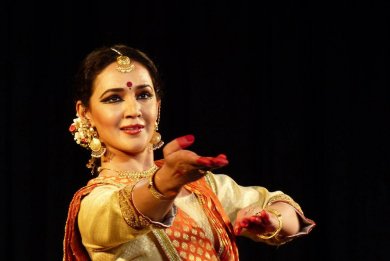 Divya Goswami Photo: Avinash Pasricha Disciple of Pune based Yogini Gandhi in Kathak for fifteen years and currently studying under Lucknow gharana's Munna Shukla, Divya Goswami has imbibed the best of Kathak. In her exposition there is no razzle dazzle, though one sees speed but also restraint. What they say in Urdu/Hindi, the word shukun, which stands for pleasurable quietude, is seen in Divya's dance. Departing from starting with energetic present day Kathak dance practice, with speed and endless chakkars, Divya seems to have chosen a peaceful prayer to begin with. She was presented by India International Centre at their auditorium recently. She has an attractive stage presence and a face which registers expressions which are not loud. Shiva aradhana, prayer in praise of Lord Shiva in Desh raga, saw her depicting it in a peaceful manner. Leisurely describing Shiva's body besmeared with ashes, serpents as ornaments, garland of skulls, matted locks from which flows Ganga, the fire in one hand and damaru in another, the vyghracharm as garment, nilakantha having swallowed poison which has stopped at his neck, trinetra, Parvati as consort, et al were enacted without any undue hurry, and the mood of devotion established gradually. It was a pretty long number, but it helped in setting the mood. For nritta, Divya selected tala Dhamar of fourteen beats. There was clarity in her footwork, the angasanchalan, the bodily movements were graceful. The extension of hands horizontally and curving above head brought in front of chest looked beautiful. The usual repertoire of thaat, aamad, parans was performed with sparkle, energy and the chakkars lent a refined look. The costumes were pleasant, the skirt while taking circles flew creating beauty of ocean waves. The few bol ki tihais she performed were perfect in terms of tala, and where she lapsed, she danced again to come on the sam. Since Dhamar has vira rasa, the mood is of valour, and the energy invested was seen clearly. The anagata, the parans with bols, mnemonics of Dhamar were performed, at times while dancing, sitting on the floor and getting up at once for the final resolution gracefully. Perhaps to show that she is proficient in ginatis - ek, do, teen, char, panch, chhe etc - she executed them in speed. She also demonstrated various jatis - mishra, tisra, chatusra - displaying her command over the technique. Gopuchha parans etc were danced competently. As usual the footwork was enjoyable. For abhinaya she chose ashtapadi "Dhira samire Yamuna teere" from the Gita Govinda. She built the environment, the banks of river Yamuna, the cool breeze and as in the ashtapadi, the sakhi narrated to Radha, how Krishna was awaiting her. Krishna drawing figures on the sand, looking in various directions for Radha's arrival were enacted showing Krishna's anguish. Divya successfully etched characters of Krishna, sakhi and Radha. Radha's enactment was more suggestive. After removing her anklets and bangles which may declare her going to Krishna, putting on dark garment, sakhi led Radha unto Krishna, who even if a leaf fell on floor, got up to see if she had come. Sung in a melodious mode after late Raghunath Panigrahi, by Madhup Mudgal's disciple Kushal, almost reminding one of his guru's style, the ashtapadi was performed aesthetically minus any exaggeration. It was the hallmark of Divya's presentation. Once the ashtapadi concluded, Divya enacted with speedy footwork, suggestive union with the lord. But it was not necessary. The ashtapadi had set excellent mood. Dancers would do well to learn where to stop, once the mood is built and the program needs to be concluded on that happy note. If this sense of aesthetics is developed by the Kathak dancers the overall impact would be enhanced instead of breaking the mood. The celebrated tabla maestro Govind Chakravarty gave her excellent support as did the flautist Kiran Kumar. His support established the peaceful mood. On sarangi Anil Kumar was in tune with flute and embellished the performance. Neha Chauhan's padhant could have been more carefully coordinated. Divya Goswami has won Bismillah Khan Yuva Puraskar from Sangeet Natak Akademi. It was heartening to see her perform so well justifying her winning the award. The awardee needs to display competence and should inspire confidence amongst presenters to give them opportunities to perform.  Dr. Sunil Kothari is a dance historian, scholar, author and critic, Padma Shri awardee and fellow, Sangeet Natak Akademi. Dance Critics' Association, New York, has honoured him with Lifetime Achievement award. Post your comments Please provide your name and email id when you use the Anonymous profile in the blog to post a comment. All appropriate comments posted with name & email id in the blog will also be featured in the site. |